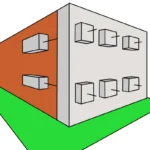Pavers: History, Types, and Contemporary Uses
Pavers are paving elements that have played a crucial role in construction and urban design for centuries. These small stone pieces, with a rich and varied history, have contributed to the aesthetics and functionality of our streets and public spaces worldwide.
What is a Paver?
A paver is a generally rectangular, cubic, or trapezoidal paving element made from various materials such as stone, concrete, brick, or wooden pavers. These pieces are laid uniformly and compactly on a surface to create a durable and aesthetically pleasing pavement. Pavers are primarily used on streets, squares, sidewalks, and courtyards to provide a durable and attractive surface.
The History of Pavers

The history of pavers is fascinating and dates back to ancient times. These small paving units have been used by various civilizations over the centuries, and their evolution has been linked to urban development and the improvement of road infrastructure. Below, we delve into the history of pavers from their origins to the present day.
Ancient Origins
The earliest evidence of paver use dates back to ancient Mesopotamia over 4,000 years ago. In this region, baked clay pavers were used to pave roads and streets. These primitive pavers were simple, but their regular arrangement provided a more solid and durable surface than dirt paths.
The Romans also played a significant role in the history of pavers. As they expanded their empire, they built an extensive network of roads paved with natural stone pavers. These roads, such as the Appian Way, became a fundamental part of Roman infrastructure and facilitated the rapid movement of troops and traders.
The Middle Ages and the Renaissance
During the Middle Ages, pavers continued to be a common feature in European cities. Natural stone and brick pavers were popular in paving streets, squares, and castle courtyards. Their durability and resistance brought significant benefits at a time when paved roads and streets were essential for trade and defense.
In the Renaissance, paver use experienced a resurgence. Paver patterns became more intricate and artistic, used to create mosaics and decorative designs in squares and courtyards. The herringbone pattern technique became popular during this period and remains a common choice today.
The 19th Century and Industrialization
During the 19th century and the era of industrialization, the use of brick pavers expanded in Europe and North America. Industrial cities needed sturdy streets to withstand carriage and horse traffic. Brick pavers were a popular choice due to their durability and ability to bear heavy loads.
During this period, there was also an increase in the manufacturing of concrete pavers. Concrete offered similar advantages in terms of strength and durability, and its production could be more easily industrialized.
The 20th Century and the Automobile Era
With the advent of the automobile in the 20th century, street and road paving underwent significant changes. Asphalt pavers became a common choice for paving roads and urban streets. Asphalt provided a smooth and durable surface for vehicular traffic and was more cost-effective to install than traditional pavers.
However, in many historic cities, streets paved with brick or natural stone pavers were preserved as part of their heritage. These cobbled streets became a symbol of the history and authenticity of these urban areas.
Pavers Today
Today, pavers continue to play a crucial role in paving streets, sidewalks, squares, and public spaces worldwide. Their versatility, strength, and load-bearing capacity make them a popular choice in a variety of applications.
Pavers are used in sustainable design projects to manage stormwater and promote water infiltration into the soil. They are also common in historic areas and historic districts, where they are used to preserve the authenticity of traditional architecture. Furthermore, modern pavers are available in a wide range of materials and styles, allowing designers to create custom pavements that meet the aesthetic and functional needs of a project.
Function of Pavers
Pavers play a fundamental role in paving urban and rural areas due to their multiple functions and advantages. Whether made of natural stone, brick, or concrete, these paving elements offer a range of benefits and fulfill various functions in pavement construction. Below, we delve into the main functions of pavers in pavement:
Load Support: One of the most important roles of pavers is to provide sturdy support for vehicular and pedestrian traffic. Pavers can withstand significant loads due to their robust construction and interconnected patterns, making them suitable for streets, roads, and squares with light or heavy traffic.
Drainage and Stormwater Management: Pavers are permeable, allowing water to pass through the joints between them. This facilitates water infiltration into the soil, reducing puddle accumulation and the risk of local flooding. Additionally, some paver patterns, such as the herringbone pattern, can be designed to guide water toward drains or gutters, further improving stormwater management.
Durability and Wear Resistance: Pavers are designed to be durable and resistant to wear. Their ability to withstand constant traffic and exposure to adverse weather conditions makes them a solid choice for long-term pavement. The durability of pavers is reflected in their extended lifespan and reduced maintenance costs over time.
Structural Stability: When installed correctly, pavers provide a stable and uniform base for pavement construction. This contributes to the structural stability of the paved surface, minimizing the formation of deformations and potholes.
Aesthetics and Design: Pavers offer a variety of design and style options, allowing the creation of attractive and aesthetically pleasing pavements. Their versatility in terms of color, shape, and pattern allows designers to create custom pavements that suit the aesthetic and functional needs of a project.
Pedestrian Accessibility: Pavers are ideal for pedestrian areas due to their even and non-slip surface. They are comfortable to walk on and provide proper accessibility for people with reduced mobility.
Simplified Maintenance and Repair: In case of damage or the need for repairs, pavers can be replaced individually, simplifying long-term maintenance. There is no need to replace entire sections of pavement, saving time and costs.
Adaptability to Irregular Terrain: Pavers adapt well to uneven or sloping terrain. Their flexibility allows them to follow the contours of the ground without the need for expensive support structures.
Reduction of Light Pollution: Light-colored pavers can help reduce light pollution in urban areas by reflecting natural and artificial light, improving nighttime visibility.
Historical and Cultural Value: In historical and cultural areas, pavers can preserve the character and heritage of the area. Many ancient pavers are still used on streets and squares worldwide as part of the cultural identity of a community.
Design Flexibility: Pavers allow for a wide variety of installation patterns, from the traditional herringbone pattern to more complex designs such as mosaics and decorative motifs. This provides designers with the flexibility needed to adapt pavement to the project’s needs and preferences.
Types of Pavers
- Natural Stone Pavers:
Granite: Granite pavers are exceptionally durable and resistant, making them suitable for areas with heavy vehicular traffic, such as urban streets, main avenues, and public squares. Their abrasion resistance makes them ideal for locations with constant wear.
Basalt: Similar to granite, basalt is suitable for heavy traffic streets and public areas. Its dark and uniform color is often chosen in modern and urban design projects.
Sandstone: Due to its more porous and less resistant nature compared to granite and basalt, sandstone pavers are mainly used in pedestrian areas, sidewalks, and patios. Their warm appearance and smooth texture make them popular in landscaping applications.
Flagstone: Flagstone is a thin, flat natural stone used in architectural and landscaping design. It is commonly used to create paths and patios in residential and commercial settings.
- Brick Pavers:

Fired Clay: Fired clay brick pavers are used in historic streets, sidewalks, and urban areas. They are a common choice in historic districts due to their traditional appearance and durability.
- Concrete Pavers:
Precast Concrete: Precast concrete pavers are versatile and used in urban streets, sidewalks, patios, squares, and residential areas. Their availability in a variety of colors and patterns allows a wide range of applications.
Stamped Concrete: These pavers are used in design projects where a specific appearance is desired, such as the imitation of stone, slate, or brick. They are used in patios, terraces, and pool areas.
- Asphalt Pavers:
Asphalt Mix: Asphalt pavers are common on roads and highways due to their ability to withstand heavy loads and constant wear. They are also used in industrial and loading areas.
- Eco-Friendly Pavers:
Permeable Pavers: These pavers are used in sustainable design projects and places where efficient water management is required, such as parking lots, stormwater drainage areas, and ecological restoration projects.
- Wooden Pavers:
Treated Wood: Wooden pavers are used in landscaping and garden areas, creating rustic paths and resting areas in natural settings. They can also be found on terraces and pool areas.
- Special Pavers:
Rubber Pavers: Rubber pavers are used in play areas, playgrounds, and sports spaces due to their ability to absorb impacts and reduce injuries.
Recycled Glass Pavers: Used in contemporary design and landscaping projects to add color and brightness to surfaces. They can also be found in squares and pedestrian areas.
- Slate Pavers:
Slate: Slate pavers are used in contemporary design projects and areas where a modern and elegant appearance is desired.
Current Uses of Pavers
Pavers are widely used in urban and rural areas today due to their multiple advantages and versatile uses. As urban planning and sustainable design gain importance, pavers remain a relevant choice for a variety of applications.

Next, we delve into the current uses of pavers:
Urban Streets and Roads: Pavers are used on urban streets and roads worldwide. They offer a sturdy and durable surface that can withstand vehicular loads and provide a stable base. Pavers are installed in specific patterns that are not only functional but also aesthetically pleasing.
Sidewalks and Pedestrian Paths: Sidewalks and pedestrian paths paved with pavers are common in urban and suburban areas. These surfaces provide a comfortable and non-slip base for pedestrians. Pavers are also used in high pedestrian traffic areas, such as commercial zones and boardwalks.
Squares and Public Spaces: Pavers are a popular choice for paving squares and other public spaces. Their versatility in terms of design and patterns allows the creation of attractive and functional areas where people can gather, rest, and enjoy the urban environment.
Historical Areas and Historic Districts: In historical areas and historic districts, pavers are used to preserve the authenticity and architectural character. These areas often retain cobblestone streets as part of their cultural and aesthetic heritage.
Parking Lots: Concrete or asphalt pavers are used in parking areas. They offer a sturdy and durable solution for commercial and residential parking lots. Additionally, their modular design allows easy repair and replacement of damaged units.
Landscaping and Garden Design: Pavers are used in landscaping and garden design projects to create paths, trails, and decorative resting areas. Their variety of colors and textures makes them ideal for integration into natural settings.
Sustainable Design Projects: Permeable pavers have become an important choice in sustainable design projects. They are made of porous materials that allow water infiltration into the soil, helping reduce surface runoff and improve water management in urban environments.
Restoration Projects: In restoration projects of historical buildings and streets, traditional pavers are used to maintain the authenticity of the era and comply with historical conservation regulations.
Toll Areas and Pedestrian Crossings: Asphalt pavers are used in toll areas and pedestrian crossings to create resilient and easy-to-maintain surfaces. Their non-slip texture enhances safety.
Patio and Terrace Design: In residential patios and terraces, concrete pavers are used to create outdoor entertainment and relaxation areas. Their versatility allows the creation of custom designs.
Benefits and Drawbacks of Pavers
Pavers are widely used paving elements in construction and urban design due to their numerous benefits, but they also have some drawbacks. Below, we detail the main benefits and drawbacks of pavers:
Benefits of Pavers:
Durability: Pavers are designed to be robust and durable. They can withstand constant vehicular and pedestrian traffic, as well as the effects of weather, making them a robust choice for paving streets, sidewalks, and squares.
Simplified Maintenance: In case of damage or the need for repairs, individual pavers can be replaced. This simplifies long-term maintenance, as there is no need to replace entire sections of pavement, saving time and costs.
Stormwater Management: Permeable pavers allow water to infiltrate the soil, reducing surface runoff and minimizing the risk of local flooding. Some paver patterns are designed to direct water toward drains or gutters, further improving stormwater management.
Design Flexibility: Pavers offer a wide variety of design options in terms of color, shape, and pattern. This allows designers to create custom pavements that suit the aesthetic and environmental requirements of a project.
Accessibility: Cobblestones provide a uniform and non-slip surface, making them ideal for pedestrian areas. They comply with accessibility standards and offer a safe and comfortable experience for pedestrians, including those with reduced mobility.
Reducing Light Pollution: Light-colored cobblestones can help reduce light pollution in urban areas by reflecting natural and artificial light, improving nighttime visibility, and reducing glare.
Preservation of Cultural Heritage: In historic and cultural areas, cobblestones are used to maintain authenticity and architectural character. Many ancient cobblestones are still used in streets and squares as part of a community’s cultural heritage.
Disadvantages of Cobblestones:
Initial Cost: Cobblestones, especially those made of natural stone, may have a higher initial cost compared to other paving materials such as asphalt or concrete.
Laborious Installation: Cobblestone installation can be a labor-intensive and skill-demanding process. Properly preparing the base and placing each cobblestone uniformly can increase the overall project cost.
Noise Level: In areas with heavy vehicular traffic, cobblestones may generate a higher noise level compared to asphalt or concrete, which can be bothersome for nearby residents.
Irregular Surface: While cobblestones provide a uniform surface, the joints between the pieces can accumulate dirt and debris over time, requiring periodic cleaning.
Slippery in Winter: In regions with cold climates, cobblestones can become slippery when covered with ice or snow, posing a risk of slips and falls.
Conclusion:
Cobblestones, paving elements with a rich and diverse history dating back to ancient times, have undergone continuous evolution over the centuries in terms of materials, designs, and applications. Today, they remain a highly valued choice in construction and urban design. Whether in historic streets, public squares, or residential courtyards, cobblestones play an essential role in shaping our urban environment.
What makes cobblestones especially appreciated is their versatility, ability to withstand constant traffic and weather conditions, and undeniable aesthetic appeal. These qualities make them a valuable choice for paving our cities and outdoor spaces. Furthermore, the growing innovation in the production of eco-friendly cobblestones reflects the increasing interest in sustainability and environmental conservation in urban design.
In summary, cobblestones serve a range of multifunctional purposes in the paving of urban and rural spaces. They not only provide durable and resilient surfaces but also contribute to efficient stormwater management, enhance pedestrian accessibility, add a distinctive aesthetic touch, and preserve cultural heritage. Their versatility and ability to adapt to various conditions have made them an indisputably popular choice in the construction and pavement design industry.







Related
What are the Non-Mechanical Properties of Materials in Civil Engineering?
Mechanical Properties of Materials (under construction)
Ecological Bricks: The Future of Sustainable Construction